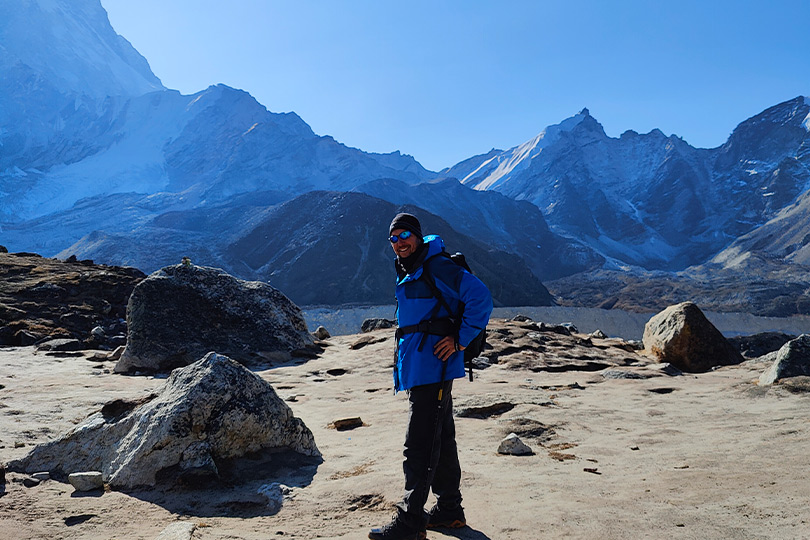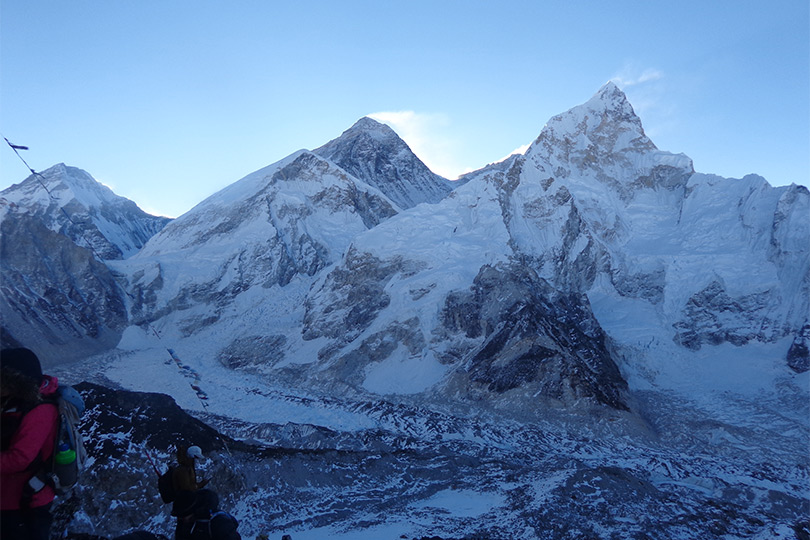The Everest base camp trek in itself is a trip of a lifetime. But as the dusk arrives and trekkers have to return to their teahouses and lodges for the night, the magic of the Himalayas becomes inaccessible. Sleeping at Everest base camp breaks the barriers of the ordinary for an exceptional experience in the Everest region. It’s one of our favorite trips ever, but here are some reasons why you should sleep at Everest base camp.
- 1. Experience high-altitude camping at Everest base camp
- 2. Take a glimpse into mountaineering
- 3. Experience the Sherpa’s sacred Puja
- 4. Capture a slice of heaven with your camera
- 5. A life-changing journey waits for you!
- 6. Tread on the infamous Khumbu Icefall
- 7. Behold the magnificent 8000-ers from Kala Patthar
- 8. You might meet the Yeti!
- How to prepare for sleeping at Everest basecamp trek:
1. Experience high-altitude camping at Everest base camp
In stark contrast to the usual teahouses, you will spend two nights camping out with tents and sleeping bags at the Everest base camp. Just like the mountaineers and climbers who go along to attempt the summit, you’ll have the opportunity to experience camping so close to the sky, at the altitude of 5,364 meters (17,598 feet).

Watch how the sky changes colors as the sun sets and rises, and how the magnificent 8000ers scrape the milky way splashed across the inky black sky. The stars will seem close enough to touch!
2. Take a glimpse into mountaineering
Standing at the foothills of Mt. Everest, you’ll find yourself exactly where countless climbers have stepped before they attempt the summit. You can imagine how they felt looking upon the imposing faces of the Himalayas; excitement, fear, joy, and fierce determination. That feeling is the stuff of dreams, and you can experience that during your sleeping at the Everest base camp trek.

Can you imagine setting up camps at the Everest base camp? Can you imagine rolling out of your sleeping bag, watching the smoke from your fire disappear in the starry sky? Can you imagine being a mountaineer for two nights? Take a step forward into your dreams of attempting the Everest summit during this trip!
3. Experience the Sherpa’s sacred Puja
Before attempting the ascent, the local Sherpa community conducts prayers where the Lama worships the spirit of Sagarmatha (Mt. Everest) to make sure the journey is auspicious. Offerings are made, prayer flags are erected, and the climbers’ gears are blessed for a successful climb.

To conclude the 2-3 hours long ceremony, Tsampa, a traditional Tibetan flour, is smeared on the climbers’ faces and thrown in the air for luck. Witnessing the puja itself is an immense blessing. Who knows, maybe next time you’ll be participating in the ritual!
4. Capture a slice of heaven with your camera
Are you an artist seeking inspiration? A filmmaker looking for stories? A photographer looking for the perfect moment? Well, this trip is perfect to uncover the hidden beauty of Everest base camp. As the most sought-after trekking trail, there are little to no surprises at the base camp itself. But when camping at base camp, you’ll be able to explore the surrounding areas, gumbas, glaciers, and capture moments so pristine that your feed will look like Discovery’s Instagram.

Snap a shot of the infamous Khumbu Icefall. Pan your camera around Kala Patthar for a panoramic view of the peaks surrounding Mt. Everest. The opportunities to create magic with your camera are endless, packed into a single trip.
5. A life-changing journey waits for you!
The Himalayas are considered to be the dwellings of the Gods in Sherpa cultures. There is no doubt about the spiritual powers of the mountains and the healing properties of an adventure. So, when we combine both into a trip of a lifetime, how could you possibly say no?

Let the traditional Sherpa rituals bring you peace. Let the cold night air of Everest base camp blow over the turbulence in your mind. If your life could use a little changing, and your spirit a little cleansing, challenge yourself with a camping trip to the Everest base camp. They say go big or go home; how long will you stay home?
6. Tread on the infamous Khumbu Icefall
A crucial part of the Everest summit journey, the Khumbu Icefall is located at the head of the Khumbu Glacier at an altitude of 5,486 meters (17,999 ft). A little farther above the base camp, it lies on the southwest of the Everest summit and is the stuff of climber’s nightmares.

To be able to behold the Khumbu Icefall in all its glittering glory as a trekker, is unimaginable. But you’ll be able to when you sleep at Everest base camp. Make the most of this unprecedented route and make your dreams come true!
7. Behold the magnificent 8000-ers from Kala Patthar
Another legendary location from the Everest base camp is Kala Patthar. Located on the south ridge of Pumori above Gorakshep at an elevation of 5,645 m (18,520 ft), it is the highest you can climb without a permit.

From the 10m ridge of Kala Patthar, you will get an unobstructed view of Mt. Everest; due to its unique ridge, it remains covered by Mt. Nuptse at most times. Not only Everest, but you will also be able to breathe the same air as the magnificent 8000ers such as Mt. Lhotse (8,516 m /27,940 ft).
8. You might meet the Yeti!
It’s the trip of a lifetime after all! Anything could happen – you could get a rare sighting of the fabled Yeti. The Himalaya’s beloved furry humanoid creature is considered a deity in some cultures and a fearsome monster in others. Guess you’ll have to meet it and find out which one it actually is!

How to prepare for sleeping at Everest basecamp trek:
1. Preparing for night temperatures
When planning to sleep at Everest base camp, you’ll only have to make a few adjustments to your regular Everest base camp Packing list. Apart from the obvious camping gear of tents, mats, and sleeping bags; we recommend you to take warm jackets, socks, and skullcaps. Depending on when you visit, the base camp can sink down to -15oC at night.
The terrain is dry and arid, and you will have to remain at a certain specified distance from the glaciers. This means that there is not much risk of your belongings getting wet. However, you can never be too careful! Do not underestimate the mountains, especially at night!
2. High Altitude Sickness and how to identify it
There is a high risk of altitude sickness in the Himalayas. The primary signifier of altitude sickness is a persistent headache. However, if not addressed in due time, it may develop into more complicated variations such as high-altitude cerebral edema (HACE) and high-altitude pulmonary edema (HAPE).
When you’re camping in one of the highest points in the world, you have to learn to identify the signs of altitude sickness so that you can seek immediate treatment. Here are some common symptoms of altitude sickness:
- Vomiting
- Loss of appetite
- Sleeplessness
- Constant headache
- Dizziness, fatigue, lethargy, heavy legs
- Light swelling of hands, feet, and face
- Breathlessness and irregular breathing
- Lesser urine
While our guides are adequately trained to help you with altitude sickness, here are some preventive measures you can take in advance:
- Take your time ascending. Go slow in higher altitudes.
- Avoid flying directly to high altitudes.
- Take 2-3 days to acclimatize
- Rest every 3-4 days while ascending
- Avoid strenuous physical activity for the first 24 hours.
- Stay hydrated
- Avoid cigarettes, caffeine, and alcohol
- Consume a light, but high-calorie diet
- Start Diamox (Acetazolamide 1-2 days before your trek, and continue throughout.
- Paracetamol for the headaches
- Anti-nausea/sickness medicine (such as Avomine)’
3. Food at the everest base camp
There are many accomodation on everest base camp trek on the way but we will be preparing our own meals when camping at the base camp. We mostly recommend you pack dry food: dehydrated fruits, trail mixes, and power bars for the way.
The food will be an assortment of bread, cereal, rice, lentils, powdered milk, crackers, and such travel-friendly food. Remember, we will focus on a higher-calorie diet, which can also involve potatoes and eggs.
Camping at Everest base camp is a dream come true. If you have further queries about your trips, don’t hesitate to contact our travel experts! Message us on Facebook, or WhatsApp us at +1-410-307-0007. Happy travels!







Thanks for the information